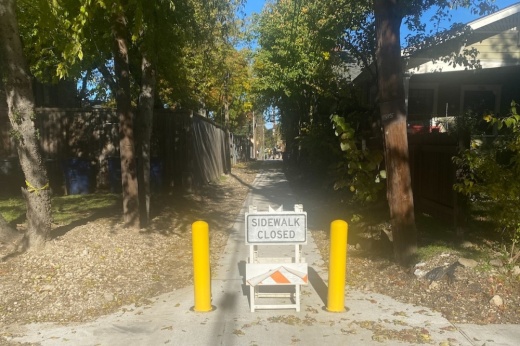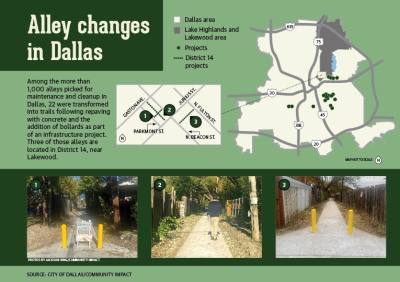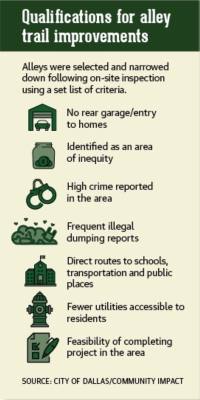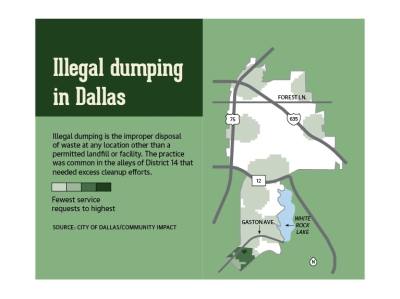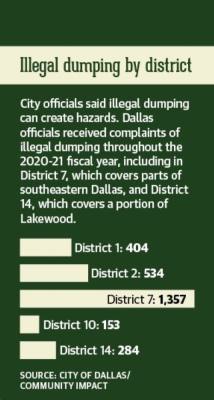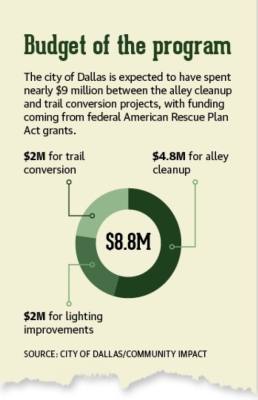The entire alley project, which includes cleaning and clearing 1,365 alleys throughout the city, cost around $8.8 million. Dallas Public Information Officer Paige Jones said the funding comes from federal American Rescue Plan Act grants from the city’s fiscal year 2021-22 budget. The grants are designed to provide for economic and infrastructure improvement uses to boost public health in response to the COVID-19 pandemic.
“Because of COVID[-19], we had the money to execute the cleanup,” said Ryan Wagoner, public relations coordinator for the Dallas Public Works Department.
Included in the FY 2021-22 budget, the Dallas Public Works Department completed the first phase of the project on April 30. Dallas City Council Member Paul Ridley, who represents a portion of Lakewood in District 14, said trash and disrepair were becoming major concerns in the alleys.
“They were totally overgrown, so we definitely needed to clean the alleys,” he said.
In addition to cleaning up, Dallas is also finishing a trail conversion project, which will turn 22 revitalized alleys in four of Dallas’ 14 council districts into walkable paths that can be used by the neighboring communities.
Those initial 22 alleys are part of a pilot program to determine feasibility, implementation methods and tools, and community involvement, according to Carpenter.
In addition to alleys in districts 1, 2 and 7, the trail conversion project altered three alleys in District 14, all of which are located in the Junius Heights Historic District neighborhood.
According to city officials, the alleys selected for the project, which were all previously unimproved, were chosen by on-site inspection based on a list of criteria and required responses from residents.
The alleys selected for conversion throughout the city include no rear garage or entry to homes; being an area of inequity; areas with high crime or frequent illegal dumping; having publicly accessed facilities, such as routes to schools, Dallas Area Rapid Transit stations, recreation centers or parks; and more.
David Bailey, a Dallas resident who lives near one of the improved alleyways in District 14, said the new trail improves walkability in the neighborhood.
“A certain percentage of property owners supported it, because I think it’s better than [what was previously there],” Bailey said. “You couldn’t walk through it at all before, so I think the area will be nicer for those who want to walk around the neighborhood.”
Demand for cleaner alleyways
Since clearing the nearly 1,400 alleys, the Dallas Public Works Department has received positive feedback from residents saying they feel the improved look and installation of lighting could help reduce crime, illegal activity and dumping in their neighborhoods, according to city officials.
“There were a lot of alleys that were overgrown and had some trash debris that required service requests to come and deal with the problem,” Wagoner said.
District 14 received 284 complaints of illegal dumping throughout FY 2020-21, while District 7 recorded 1,357 complaints during the same time span. District 1 received 404 complaints, and District 2 had 534 complaints. District 10, which initially had an alley scheduled for conversion before it was removed for lack of feasibility, received 153 complaints over the 2020-21 fiscal year.
“Not only is [illegal dumping] a major nuisance for neighborhoods and residents, but it can also cause major public health and safety concerns—like increases in harmful pests, and potential physical and chemical hazards,” Carpenter said.
Bailey said it shocked him how many alleys in the city of Dallas were completely overgrown due to dumping and other related issues.
“This [alley] wasn’t too bad, but every once in a while we’d get dumped on,” he said. “Now that they’ve landscaped it, I intend to plant some stuff back there to enhance it even further.”
Dallas Police Department Sgt. Warren Mitchell said the effort to clean alleyways and clear up debris will contribute toward lowering crime and other issues within these neighborhoods.
“Any revitalization project, whether it’s making sure the pipes are working or the street lights are on, benefits the community,” Mitchell said.
Trail conversion
Wagoner said the pilot program for converting the alleys into trails was added to the clearing project based on public interest.
The project includes installation of a five-foot-wide concrete sidewalk within the middle of the existing 10-foot-wide alley as well as two bollards at the ends of each of the alleys. The bollards, which are short posts used to divert traffic from an area, are designed to be removable. The project also includes the installation of street lights at heights of 14 feet in the historic district and 18-20 feet in the nonhistoric districts.
“This pilot program is one of several projects that public works and the city at large have implemented to improve the look, feel, safety and walkability of Dallas neighborhoods,” Carpenter said.
Javier Rodriguez, who lives near an alley converted behind Junius Street, said he feels like the city should have just poured a driveway.
“Even the driveway could still be a walkway, you can just put signs for no cars to come in unless it’s an emergency car,” Rodriguez said. “I know that [the bollards] are here to keep cars from going through [the alley], but they should have gone ahead and made it wide enough so you’d like to see police having access.”
Wagoner said he has been encouraged by how the city has worked to accomplish the project with the feedback and assistance from the community. He added that the city expects to wrap up alleyway trail conversions by the end of the year.
“There’s a potential to turn this program into not just a pilot, so that would be really great to see it expand as an offer for the [entire] city,” he said.
The potential to incorporate further trail conversion projects is likely to be discussed ahead of a 2024 Dallas Bond election, according to Wagoner. Citizens and neighborhoods will have the ability to express input on potential infrastructure improvements, such as trails, parks, street improvements and other neighborhood projects.
Supply chain issues caused by the COVID-19 pandemic forced the project to switch the material for the planned trail paths from being made of decomposed granite to concrete. Wagoner said the use of concrete will not affect usability of the new alleys.
“With a granite pathway, it’s just going to look a lot cleaner in terms of the actual layout, but a concrete pathway will still be nice,” he said. “It’s going to look very similar to what you’d see on an improved sidewalk.”
Rebecca Heliot contributed to this article.




